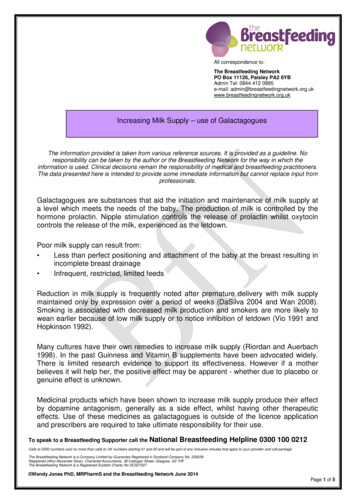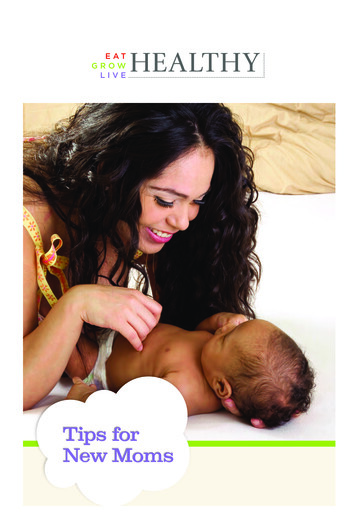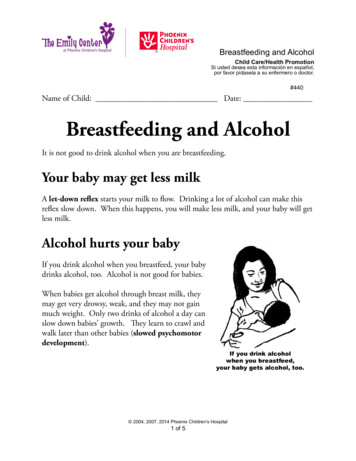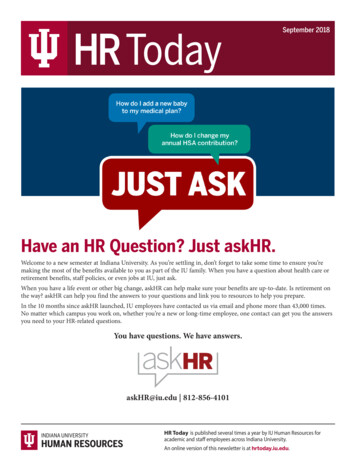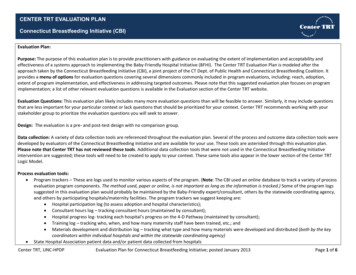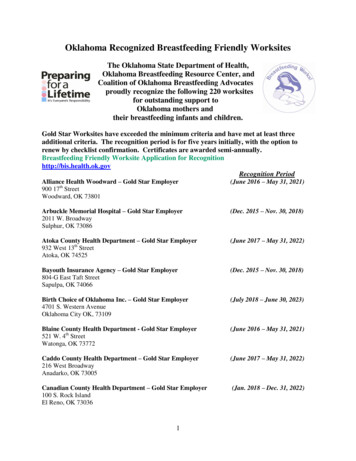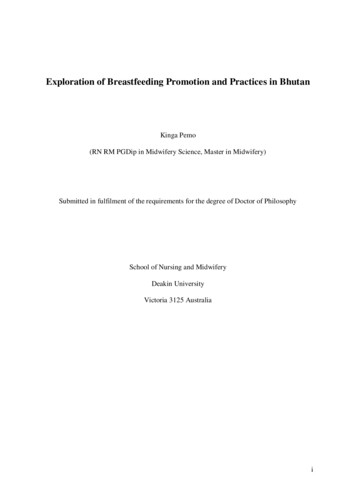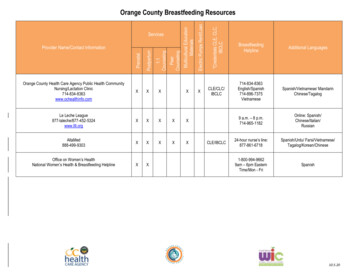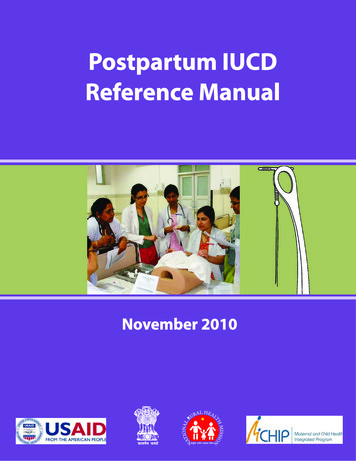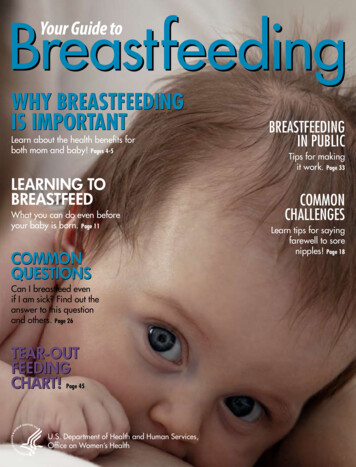
Transcription
BreastfeedingYour Guide toWhy Breastfeedingis importantLearn about the health benefits forboth mom and baby! Pages 4-5Learning toBreastfeedWhat you can do even beforeyour baby is born. Page 11CommonQuestionsCan I breastfeed evenif I am sick? Find out theanswer to this questionand others. Page 26Tear-outFeedingChart!Page 45U.S. Department of Health and Human Services,Office on Women’s HealthBreastfeedingin PublicTips for makingit work. Page 33CommonChallengesLearn tips for sayingfarewell to sorenipples! Page 18
Your Guide to BreastfeedingIntroductionThe experience of breastfeeding is special for so many reasons, including: The joyful bonding with your babyThe perfect nutrition only you can provideThe cost savingsThe health benefits for both mother and babyIn fact, breast milk has disease-fighting antibodies that canhelp protect infants from several types of illnesses. And mothers who breastfeed have a lower risk of some health problems,including breast cancer and type 2 diabetes.Keep in mind that breastfeeding is a learned skill. It requirespatience and practice. For some women, the learning stages can befrustrating and uncomfortable. And some situations make breastfeeding even harder, such as babies born early or health problems inthe mother. The good news is that it will get easier, and support forbreastfeeding mothers is growing.You are special because you can make the food that is uniquely perfect for your baby. Invest the time in yourself and your baby– for your health and for the bond that will last a lifetime.The U.S. Department of Health and Human Services’ Office on Women’sHealth (OWH) is raising awareness of the importance of breastfeeding tohelp mothers give their babies the best start possible in life. In addition tothis guide, OWH offers online content at http://www.womenshealth.gov/breastfeeding and provides the National Breastfeeding Helpline at 800-9949662. The Surgeon General’s Call to Action to Support Breastfeeding putsforth steps that family members, communities, clinicians, health care systems,and employers can take to make breastfeeding an easy choice for mothers.Learn more at http://www.surgeongeneral.gov. OWH also partners withthe Health Resources and Services Administration’s Maternal and ChildHealth Bureau to educate employers about the needs of breastfeedingmothers via The Business Case for Breastfeeding.The Affordable Care Act (health care reform) helps pregnant women andbreastfeeding mothers get the medical care and support they and theirchildren need. Learn more at http://www.healthcare.gov.U.S. Department of Health and Human Services,Office on Women’s Health2January 2011
Contents4Why Breastfeeding is important6finding support and information8how Breast milk is made10Before you give Birth11Learning to Breastfeed18Common Challenges25Common Questions28Breastfeeding a Baby with HealthProblemsHealth benefits for babies and mothersTypes of health professionals who can help with breastfeeding, and how to find support by phoneHow your body meets your baby’s nutrition needsSteps you can take before the baby arrives, and whatyour family members can doHow to hold your baby and know if your baby is gettingenough breast milkTips for troubleshooting common problemsFind out if your baby needs cereal, if you can takemedicine, and moreDealing with jaundice, reflux, and cleft palate and lipTools you can useBreast milk storage guide, page 36Jot it down: questions to ask yourbaby’s doctor (page 43) andquestions to ask your health careprovider (page 44)Tear-out feeding chart, page 4530Breastfeeding and Special Situations33Breastfeeding in Public34Pumping and Milk Storage37Going Back to Work39Nutrition and Fitness42Handling Stress43Tear-out toolsInformation for mothers of multiples, mothers who areadopting, and moreWays to feel comfortable feeding your baby while outand aboutDifferent ways to express breast milk and how to store itYour rights and how to talk to your employer about yourbreastfeeding needsHow to take care of yourself while breastfeedingCoping tips to keep stress at bayWrite down questions to ask your doctor and yourbaby’s doctor, and keep track of diapers and feedings3
Why Breastfeeding is importantBreastfeeding Protects Babies1. Early breast milk is liquid gold.Known as liquid gold, colostrum (coh-LOSStrum) is the thick yellow first breast milk thatyou make during pregnancy and just after birth.This milk is very rich in nutrients and antibodies to protect your baby. Although yourbaby only gets a small amount of colostrum ateach feeding, it matches the amount his or hertiny stomach can hold. (See page 17 to see justhow small your newborn’s tummy is!)2. Your breast milk changes as your baby grows.Colostrum changes into what is calledmature milk. By the third to fifth day afterbirth, this mature breast milk has just theright amount of fat, sugar, water, and protein to help your baby continue to grow. It isa thinner type of milk than colostrum, but itprovides all of the nutrients and antibodiesyour baby needs.3. Breast milk is easier to digest.For most babies – especially premature babies– breast milk is easier to digest than formula.The proteins in formula are made from cow’smilk, and it takes time for babies’ stomachs toadjust to digesting them.4. Breast milk fights disease.The cells, hormones, and antibodies in breastmilk protect babies from illness. This protection is unique; formula cannot match thechemical makeup of human breast milk. Infact, among formula-fed babies, ear infectionsand diarrhea are more common. Formula-fedbabies also have higher risks of: Necrotizing (nek-roh-TEYE-zing) enterocolitis (en-TUR-oh-coh-lyt-iss), a diseasethat affects the gastrointestinal tract in preterm infants. Lower respiratory infections Atopic dermatitis, a type of skin rash Asthma Obesity Type 1 and type 2 diabetes Childhood leukemiaBreastfeeding has also been shown to lower therisk of SIDS (sudden infant death syndrome).Formula-feeding can raise health risks in babies,but there are rare cases in which formula may be anecessary alternative. Very rarely, babies are bornunable to tolerate milk of any kind. These babiesmust have soy formula. Formula may also be neededif the mother has certain health conditions and shedoes not have access to donor breast milk. To learnmore about rare breastfeeding restrictions in themother, see page 26. To learn more about donormilk banks, see page 32.Breastfeeding GlossaryNutrients are any food substance that provides energy or helps build tissue.Antibodies (AN-teye-bah-deez) are blood proteins made in response to germs or other foreign substances that enterthe body. Antibodies help the body fight illness and disease by attaching to germs and marking them for destruction.The gastrointestinal system is made up of the stomach, and the small and large intestines. It breaks down andabsorbs food.The respiratory system includes the nose, throat, voice box, windpipe, and lungs. Air is breathed in, delivering oxygen. Waste gas is removed from the lungs when you breathe out.4
Mothers Benefit from Breastfeeding1. Ways that breastfeeding can make yourlife easier.Breastfeeding may take a little more effortthan formula feeding at first. But it can makelife easier once you and your baby settle into agood routine. When you breastfeed, there areno bottles and nipples to sterilize. You do nothave to buy, measure, and mix formula. Andthere are no bottles to warm in the middle ofthe night.2. Breastfeeding can save money.Formula and feeding supplies can cost wellover 1,500 each year, depending on how muchyour baby eats. Breastfed babies are also sickless often, which can lower health care costs.3. Breastfeeding can feel great.Physical contact is important to newborns. Itcan help them feel more secure, warm, andcomforted. Mothers can benefit from thiscloseness, as well. Breastfeeding requires amother to take some quiet relaxed time tobond. The skin-to-skin contact can boost themother’s oxytocin (OKS-ee-TOH-suhn) levels.Oxytocin is a hormone that helps milk flowand can calm the mother.4. Breastfeeding can be good for the mother’shealth, too.Breastfeeding is linked to a lower risk of thesehealth problems in women: Type 2 diabetes Breast cancer Ovarian cancer Postpartum depressionExperts are still looking at the effects ofbreastfeeding on osteoporosis and weight lossafter birth. Many studies have reported greaterweight loss for breastfeeding mothers than forthose who don’t. But more research is neededto understand if a strong link exists.Breastfeeding During anEmergencyWhen an emergency occurs, breastfeeding cansave lives: Breastfeeding protects babies from the risksof a contaminated water supply. Breastfeeding can help protect against respiratory illnesses and diarrhea. These diseasescan be fatal in populations displaced bydisaster. Breast milk is the right temperature for babiesand helps to prevent hypothermia when thebody temperature drops too low. Breast milk is readily available without needing other supplies.5. Nursing mothers miss less work.Breastfeeding mothers miss fewer days fromwork because their infants are sick less often.Breastfeeding Benefits SocietyThe nation benefits overall when mothers breastfeed. Recent research shows that if 90 percent offamilies breastfed exclusively for 6 months, nearly1,000 deaths among infants could be prevented.The United States would also save 13 billion peryear – medical care costs are lower for fully breastfed infants than for never-breastfed infants. Breastfed infants typically need fewer sick care visits,prescriptions, and hospitalizations.Breastfeeding also contributes to a more productive workforce because mothers miss less work tocare for sick infants. Employer medical costs arealso lower.Breastfeeding is also better for the environment.There is less trash and plastic waste compared tothat produced by formula cans and bottle supplies.5
Finding Support and InformationWhile breastfeeding is natural, you still may needsome advice. There are many sources of supportavailable for breastfeeding mothers. You can seekhelp from different types of health professionals,organizations, and members of your own family.Under the Affordable Care Act (health care reform), more and more women will have access tobreastfeeding support without any out-of-pocketcosts. And don’t forget, friends who have successfully breastfed can be a great source of information and encouragement!Health Professionals Who Help withBreastfeedingPediatricians, obstetricians, and certified nursemidwives can help you with breastfeeding. Otherspecial breastfeeding professionals include: International Board Certified LactationConsultant (IBCLC). Lactation consultantsare credentialed breastfeeding professionalswith the highest level of knowledge and skill inbreastfeeding support. IBCLCs are experiencedin helping mothers to breastfeed comfortably byhelping with positioning, latch, and a wide rangeof breastfeeding concerns. Many IBCLCs arealso nurses, doctors, speech therapists, dietitians,or other kinds of health professionals. Ask yourhospital or birthing center for the name of alactation consultant who can help you. Or, youcan go to http://www.ilca.org to find an IBCLCin your area. Breastfeeding Peer Counselor or Educator. Abreastfeeding counselor can teach others aboutthe benefits of breastfeeding and help womenwith basic breastfeeding challenges and questions.A “peer” means a person has breastfed her ownbaby and is available to help other mothers. Somebreastfeeding educators have letters after theirnames like CLC (Certified Lactation Counselor)or CBE (Certified Breastfeeding Educator).6Educators have special breastfeeding training butnot as much as IBCLCs. These professionals stillcan be quite helpful. Doula (DOO-la). A doula is professionallytrained and experienced in giving social supportto birthing families during pregnancy, labor,and birth and at home during the first few daysor weeks after birth. Doulas who are trained inbreastfeeding can help you be more successfulwith breastfeeding after birth.Mother-to-Mother SupportOther breastfeeding mothers can be a great sourceof support. Mothers can share tips and offer oneanother encouragement. There are many ways youcan connect with other breastfeeding mothers: Ask your health care provider or hospital staffto recommend a support group.
Search your phone book or the Internet for abreastfeeding center near you. These centersmay offer support groups. Find a local La Leche League support groupby visiting the organization’s website at http://www.llli.org/.Learn more about breastfeeding basicsand find other online resources athttp://www.womenshealth.gov/breastfeeding. Search the Internet for breastfeeding messageboards and chats. (These resources can be greatfor sharing tips, but do not rely on websites formedical advice – talk to your health care provider.)WIC ProgramFood, nutrition counseling, and access to healthservices are provided to low-income women, infants, and children under the Special SupplementalNutrition Program for Women, Infants, and Children. This program is popularly known as WIC(Women, Infants, and Children). Breastfeedingmothers supported by WIC may receive educational materials, peer counselor support, an enhancedfood package, breast pumps, and other supplies.Breastfeeding mothers are also eligible to participate in WIC longer than non-breastfeeding mothers. To find contact information for your localWIC program, visit edingmainpage.htm or callthe national office at 703-305-2746.The National Breastfeeding HelplineThe National Breastfeeding Helpline from the Office on Women’s Health has trained breastfeeding peer counselorsto provide support by phone. The counselors can help answer common breastfeeding questions. They can alsohelp you decide if you need to see a doctor or lactation consultant. The Helpline is available for all breastfeedingmothers, partners, prospective parents, family members, and health professionals seeking to learn more aboutbreastfeeding. The Helpline is open from Monday through Friday, from 9 a.m. to 6 p.m., EST. If you call afterhours, you will be able to leave a message, and a breastfeeding peer counselor will return your call on the nextbusiness day. Help is available in English or Spanish.Call 800-994-9662 for Support!7
HKnowing how the breast works to produce milkcan help you understand the breastfeeding process.The breast itself is a gland that is made up of several parts, including: Lymph – the almost colorless fluid that travelsthrough the lymphatic system and carries cellsthat help fight infection and disease. Lymph tissue in the breast helps remove waste. Glandular tissue – body tissue that makes andreleases one or more substances for use in thebody. Some glands make fluids that affect tissues or organs. Others make hormones or assistwith blood production. In the breast, this tissueis involved in milk production. Nerves – cells that are the building blocks ofthe nervous system (the system that records andtransmits information chemically and electrically within a person). Nerve tissue in the breastmakes breasts sensitive to touch, allowing thebaby’s sucking to stimulate the let-down ormilk-ejection reflex and milk production. (Seepage 9 to learn how let-down works!) Connective tissue – a type of body tissue thatsupports other tissues and binds them together.This tissue provides support in the breast. Blood – fluid in the body made up of plasma,red and white blood cells, and platelets. Bloodcarries oxygen and nutrients to and waste materials away from all body tissues. In the breast,blood nourishes the breast tissue and providesnutrients needed for milk production. Fatty tissue – connective tissue that containsstored fat. It is also known as adipose tissue.Fatty tissue in the breast protects the breastfrom injury. Fatty tissue is what mostly affectsthe size of a woman’s breast. Breast size doesnot have an effect on the amount of milk orthe quality of milk a woman makes.Lobe(Each mammary gland forms a lobe of the breast,which consists of a single major branch of alveoliand milk ducts that end at the nipple pore)Areola(The dark area around the nipple)NippleMilk duct(Tube through which milk travels)Alveoli cells(Grape-like clusters of tissue that secrete milk)8
What is a let-down reflex?A let-down reflex or milk ejection reflex isa conditioned reflex ejecting milk from thealveoli through the ducts to the sinuses of thebreast and the nipple. (See the anatomy of thebreast on page 8.) This reflex makes it easierto breastfeed your baby. Let-down happens afew seconds to several minutes after you startbreastfeeding your baby. It can happen a fewtimes during a feeding, too. You may feel atingle in your breast or you may feel a littleuncomfortable. Keep in mind that some womendon’t feel anything.Let-down can happen at other times, too, suchas when you hear your baby cry or when youmay just be thinking about your baby. If yourmilk lets down as more of a gush and it bothersyour baby, try expressing some milk by handbefore you start breastfeeding.Special cells inside your breasts make milk. Thesecells are called alveoli (al-VEE-uh-leye). When yourbreasts become fuller and tender during pregnancy,this is a sign that the alveoli are getting ready towork. Some women do not feel these changes intheir breasts. Others may sense these changes aftertheir baby is born.The alveoli make milk in response to the hormoneprolactin (proh-LAK-tin). Prolactin rises when thebaby suckles. Another hormone, oxytocin (oks-eeTOH-suhn), causes small muscles around the cellsto contract and move the milk through a series ofsmall tubes called milk ducts. This moving of themilk is called let-down reflex.Oxytocin also causes the muscles of the uterusto contract during and after birth. This helps theuterus to get back to its original size. It also lessensany bleeding a woman may have after giving birth.The release of both prolactin and oxytocin may beresponsible in part for a mother’s intense feeling ofneeding to be with her baby.9
Before You give BirthTo prepare for breastfeeding, the most importantthing you can do is have confidence in yourself.Committing to breastfeeding starts with the beliefthat you can do it!Other steps you can take to prepare for breastfeeding:1. Get good prenatal care, which can help youavoid early delivery. Babies born too early often need special care, which can make breastfeeding harder.lationship before the baby comes, or be readyif you need help after the baby is born.4. Talk to your health care provider about yourhealth. Discuss any breast surgery or injury youmay have had. If you have depression or aretaking medications, discuss treatment optionsthat can work with breastfeeding.2. Take a breastfeeding class.5. Tell your health care provider that you wouldlike to breastfeed your newborn baby as soonas possible after delivery. The sucking instinctis very strong within the first hour of life.3. Ask your health care provider to recommenda lactation consultant. You can establish a re-6. Talk to friends who have breastfed or considerjoining a breastfeeding support group.Talk to Fathers, Partners, and OtherFamily Members About How TheyCan HelpBreastfeeding is more than a way to feed a baby – itbecomes a lifestyle. And fathers, partners, and other special support persons can be involved in the breastfeedingexperience, too. Partners and family members can: Support the breastfeeding relationship by beingkind and encouraging. Show their love and appreciation for all of thework that is put into breastfeeding. Be good listeners when a mother needs to talkthrough breastfeeding concerns. Make sure the mother has enough to drink and getsenough rest, help around the house, and take careof other children at home. Give emotional nourishment to the child throughplaying and cuddling.Fathers, partners, and other people in the mother’s support system can benefit from breastfeeding, too. Not onlyare there no bottles to prepare, but many people feelwarmth, love, and relaxation just from sitting next to amother and baby during breastfeeding.10What Dad Can DoThe bond between mother and baby isimportant, but so is the bond betweenfather and baby. Babies need cuddlesand hugs from their dads, too! In fact,skin-to-skin contact helps baby andfather bond much like it does for motherand baby.
Learning to BreastfeedBreastfeeding is a process that takes time to master.Babies and mothers need to practice. Keep in mindthat you make milk in response to your baby sucking at the breast. The more milk your baby removesfrom the breasts, the more milk you will make.After you have the baby, these steps can help youget off to a great start: Breastfeed as soon as possible after birth. Ask for an on-site lactation consultant to comehelp you. Ask the staff not to give your baby other foodor formula, unless it is medically necessary. Allow your baby to stay in your hospital room all dayand night so that you can breastfeed often. Or, askthe nurses to bring your baby to you for feedings. Try to avoid giving your baby any pacifiers orartificial nipples so that he or she gets used tolatching onto just your breast. (See page 12 tolearn about latching.)How often should I breastfeed?Early and often! Breastfeed as soon as possible afterbirth, then breastfeed at least 8 to 12 times every 24hours to make plenty of milk for your baby. This meansthat in the first few days after birth, your baby willlikely need to breastfeed about every hour or two inthe daytime and a couple of times at night. Healthybabies develop their own feeding schedules. Followyour baby’s cues for when he or she is ready to eat.How long should feedings be?Feedings may be 15 to 20 minutes or longer per breast.But there is no set time. Your baby will let you knowwhen he or she is finished. If you are worried that yourbaby is not eating enough, talk to your baby’s doctor.See page 45 for a feeding tracker if you would like towrite down when your baby wants to eat.11
Bringing Your Baby to the BreastWhen awake, your baby will move his or her headback and forth, looking and feeling for the breastwith his or her mouth and lips. The steps belowcan help you get your baby to “latch” on to thebreast to start eating. Keep in mind that there is noone way to start breastfeeding. As long as the babyis latched on well, how you get there is up to you. Hold your baby, wearing only a diaper, againstyour bare chest. Hold the baby upright with hisor her head under your chin. Your baby will becomfortable in that cozy valley between yourbreasts. You can ask your partner or a nurseto place a blanket across your baby’s back andbring your bedcovers over you both. Your skintemperature will rise to warm your baby. Support his or her neck and shoulders with onehand and hips with the other. He or she maymove in an effort to find your breast. Your baby’s head should be tilted back slightlyto make it easy to suck and swallow. With his orher head back and mouth open, the tongue isnaturally down and ready for the breast to go ontop of it. Allow your breast to hang naturally. When yourbaby feels it with his or her cheek, he or shemay open his or her mouth wide and reach it upand over the nipple. You can also guide the babyto latch on as you see in these illustrations. At first, your baby’s nose will be lined up opposite your nipple. As his or her chin presses intoyour breast, his or her wide open mouth willget a large mouthful of breast for a deep latch.Keep in mind that your baby can breathe at thebreast. The nostrils flare to allow air in. Tilt your baby back, supporting your baby’shead, upper back, and shoulders with the palmof your hand and pull your baby in close.Some babies latch on right away, and for some ittakes more time.12Getting your baby to latch:Tickle the baby’s lips toencourage him or herto open wide.Pull your baby close sothat the chin and lowerjaw moves into yourbreast first.Watch the lower lip andaim it as far from thebase of the nipple aspossible, so the babytakes a large mouthfulof breast.When my son was born 4 years ago, we had a verydifficult time breastfeeding because he wasn’t latching correctly. He seemed almost lazy and disinterested in eating. In the first 2 weeks, he lost quite a bitof weight and appeared gaunt and fussy. Naturally,I was nearly frantic with worry. Luckily, I connectedwith an amazing lactation consultant. She put me ona rigorous, week-long regimen which consisted ofnursing, then bottle feeding breast milk, then pumping every 3 hours. I was completely dedicated to theregimen, and when I met with her a week later, shewas stunned by the results. My son had gained anentire pound, and she said he had developed a perfect latch. She called us the miracle mom and miraclebaby! I was so proud of us. My determination paidoff and I enjoyed breastfeeding for 7 months.– JillBridgewater, MA
Signs of a good latchHelp with latch problems The latch feels comfortable to you, withouthurting or pinching. How it feels is more important than how it looks.Are you in pain? Many moms report that theirbreasts can be tender at first until both they andtheir baby find comfortable breastfeeding positions and a good latch. Once you have done this,breastfeeding should be comfortable. If it hurts,your baby may be sucking on only the nipple.Gently break your baby’s suction to your breast byplacing a clean finger in the corner of your baby’smouth and try again. Also, your nipple should notlook flat or compressed when it comes out of yourbaby’s mouth. It should look round and long, orthe same shape as it was before the feeding. Your baby’s chest is against your body and he orshe does not have to turn his or her head whiledrinking. You see little or no areola, depending on thesize of your areola and the size of your baby’smouth. If areola is showing, you will see moreabove your baby’s lip and less below. When your baby is positioned well, his or hermouth will be filled with breast. The tongue is cupped under the breast, although you might not see it. You hear or see your baby swallow. Some babiesswallow so quietly, a pause in their breathingmay be the only sign of swallowing. You see the baby’s ears “wiggle” slightly. Your baby’s lips turn out like fish lips, not in.You may not even be able to see the bottom lip. Your baby’s chin touches your breast.A Good LatchA good latch is important for your baby to breastfeed effectively and for your comfort. During theearly days of breastfeeding, it can take time andpatience for your baby to latch on well.Are you or your baby frustrated? Take a shortbreak and hold your baby in an upright position.Try holding him or her between your breasts skinto your skin. Talk, sing, or provide your finger forsucking for comfort. Try to breastfeed again in alittle while. Or, the baby may start moving to thebreast on his or her own from this position.Does your baby have a weak suck or make onlytiny suckling movements? Break your baby’s suction and try again. He or she may not have a deepenough latch to remove the milk from your breast.Talk with a lactation consultant or pediatrician ifyour baby’s suck feels weak or if you are not surehe or she is getting enough milk. Rarely, a healthproblem causes the weak suck.13
Breastfeeding HoldsSome moms find that the following positions are helpful ways to get comfortable and support their babiesin finding a good latch. You also can use pillows under your arms, elbows, neck, or back to give you addedcomfort and support. Keep in mind that what works well for one feeding may not work well for the next.Keep trying different positions until you are comfortable.1. Cradle hold – an easy, common hold that is comfortable for mostmothers and babies. Hold your baby with his or her head on your forearm and his or her whole body facing yours.2. Cross cradle or transitional hold – useful for premature babies orbabies with a weak suck because it gives extra head support and mayhelp babies stay latched. Hold your baby along the opposite arm fromthe breast you are using. Support your baby’s head with the palm ofyour hand at the base of his or her neck.3. Clutch or “football” hold – useful for mothers who had a c-sectionand mothers with large breasts, flat or inverted nipples, or a stronglet-down reflex (see page 9). It is also helpful for babies who prefer tobe more upright. This hold allows you to better see and control yourbaby’s head and to keep the baby away from a c-section incision. Holdyour baby at your side, lying on his or her back, with his or her headat the level of your nipple. Support baby’s head with the palm of yourhand at the base of the head. (The baby is placed almost under thearm.)4. Side-lying position – useful for mothers who had a c-section or tohelp any mother get extra rest while the baby breastfeeds. Lie on yourside with your baby facing you. Pull your baby close so your baby facesyour body.14
Tips for Making It Work1. Learn your baby’s hunger signs. Whenbabies are hungry, they become more alertand active. They may put their hands or fiststo their mouths, make sucking motions withtheir mouth, or turn their heads looking for thebreast. If anything touches the baby’s cheek –such as a hand – the baby may turn toward thehand, ready to eat. This sign of hunger is calledrooting. Offer your breast when your babyshows rooting signs. Crying can be a late signof hunger, and it may be harder to latch oncethe baby is upset. Over time, you will be able tolearn your baby’s cues for when to start feeding.2. Follow your baby’s lead. Make sure you areboth comfortable and follow your baby’s leadafter he or she is latched on well. Some babiestake both breasts at each feeding. Other babiesonly take one breast at a feeding. Help yourbaby finish the first breast, as long as he or sheis still sucking and s
How to hold your baby and know if your baby is getting enough breast milk. 18 Common Challenges. Tips for troubleshooting common problems. 25 Common Questions. Find out if your baby needs cereal, if you can take medicine, and more. 28 Breastfeeding a Baby with . health Problems
